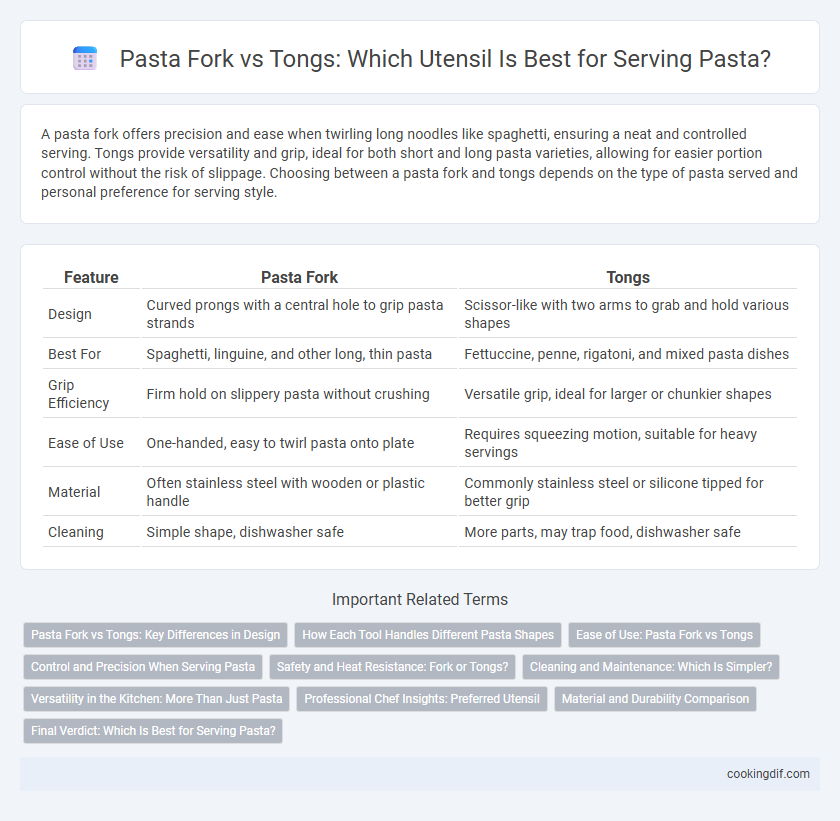A pasta fork offers precision and ease when twirling long noodles like spaghetti, ensuring a neat and controlled serving. Tongs provide versatility and grip, ideal for both short and long pasta varieties, allowing for easier portion control without the risk of slippage. Choosing between a pasta fork and tongs depends on the type of pasta served and personal preference for serving style.
Table of Comparison
| Feature | Pasta Fork | Tongs |
|---|---|---|
| Design | Curved prongs with a central hole to grip pasta strands | Scissor-like with two arms to grab and hold various shapes |
| Best For | Spaghetti, linguine, and other long, thin pasta | Fettuccine, penne, rigatoni, and mixed pasta dishes |
| Grip Efficiency | Firm hold on slippery pasta without crushing | Versatile grip, ideal for larger or chunkier shapes |
| Ease of Use | One-handed, easy to twirl pasta onto plate | Requires squeezing motion, suitable for heavy servings |
| Material | Often stainless steel with wooden or plastic handle | Commonly stainless steel or silicone tipped for better grip |
| Cleaning | Simple shape, dishwasher safe | More parts, may trap food, dishwasher safe |
Pasta Fork vs Tongs: Key Differences in Design
Pasta forks feature long, curved prongs designed to grip and separate strands of pasta effectively, ensuring precise serving without clumping. In contrast, pasta tongs have a scissor-like design with broad, flat edges that can grasp larger portions of pasta, including thicker varieties like fettuccine or penne. The key difference lies in the fork's ability to handle delicate, slippery noodles versus the tongs' strength in managing bulkier pasta shapes with minimal effort.
How Each Tool Handles Different Pasta Shapes
Pasta forks excel at handling long, thin pasta such as spaghetti or linguine by allowing strands to be twirled neatly without slipping. Pasta tongs provide a better grip for thicker, chunkier shapes like penne or rigatoni, enabling easier scooping and serving. Choosing the right tool enhances portion control and maintains the integrity of delicate pasta textures during serving.
Ease of Use: Pasta Fork vs Tongs
Pasta forks feature pronged edges designed to grip and separate noodles efficiently, making them ideal for serving long pasta like spaghetti with minimal slippage. Tongs offer a versatile grip, allowing users to handle varied pasta shapes and portions, but may require more dexterity to control slippery noodles. The choice between pasta fork and tongs depends on the pasta type and user preference for precision or versatility during serving.
Control and Precision When Serving Pasta
Using a pasta fork offers superior control and precision when serving spaghetti or linguine, allowing strands to be neatly twirled without slipping. Pasta tongs provide a firmer grip ideal for thicker varieties like fettuccine or penne, minimizing spills during transfer from pot to plate. Selecting the right utensil enhances portion accuracy and presentation, ensuring a flawless pasta serving experience.
Safety and Heat Resistance: Fork or Tongs?
Pasta tongs are generally safer for serving hot pasta as they offer a better grip and keep hands farther from heat sources, reducing burn risks. Forks may pose a higher chance of slipping and require closer proximity to hot steam or boiling water. High-quality pasta tongs made from heat-resistant materials like silicone or stainless steel enhance safety and durability during serving.
Cleaning and Maintenance: Which Is Simpler?
Pasta forks with fewer grooves and simpler shapes are generally easier to clean, reducing food residue buildup and minimizing the risk of bacteria. Tongs, especially those with intricate hinge mechanisms or silicone grips, might require more thorough cleaning to avoid trapped debris and ensure hygiene. Choosing utensils made of dishwasher-safe materials further simplifies maintenance and promotes longevity.
Versatility in the Kitchen: More Than Just Pasta
Pasta forks excel at twirling long noodles like spaghetti, providing precise control for delicate servings while also doubling as a tool for tossing salads or retrieving items from boiling water. Tongs offer enhanced versatility by gripping various food shapes, from thick pasta shells to roasted vegetables, making them ideal for flipping, serving, and portioning a wide range of dishes. Both utensils complement kitchen tasks but tongs deliver broader functionality beyond pasta, supporting diverse cooking and serving needs.
Professional Chef Insights: Preferred Utensil
Professional chefs often prefer pasta forks for serving due to their tapered tines, which allow better grip and separation of long noodles like spaghetti and fettuccine. Pasta forks facilitate portion control and plating precision, essential in high-end culinary settings. In contrast, tongs are favored for versatility and ease with various pasta shapes but may lack the finesse required for delicate presentations.
Material and Durability Comparison
Pasta forks often feature stainless steel or durable plastic materials that resist corrosion and provide long-lasting strength for twisting and lifting spaghetti and other long pasta. Tongs are commonly made from stainless steel with silicone tips, combining the metal's durability with non-stick protection to prevent scratching cookware and ensure a secure grip. Both tools prioritize materials that balance heat resistance and robustness, though stainless steel tongs generally offer superior durability under frequent use and heavy handling.
Final Verdict: Which Is Best for Serving Pasta?
A pasta fork offers precision and control, making it ideal for serving long noodles like spaghetti by easily gripping and twisting them. Pasta tongs provide versatility and efficiency, especially for mixed dishes or thicker pasta varieties, allowing you to serve larger portions quickly. Choosing between the two depends on the pasta type and serving style, but a pasta fork generally excels in handling delicate, slippery noodles with finesse.
Pasta fork vs tongs for serving Infographic

 cookingdif.com
cookingdif.com